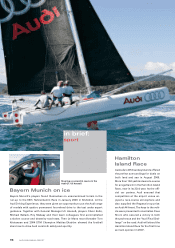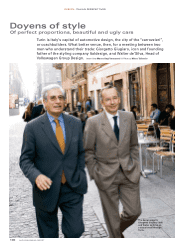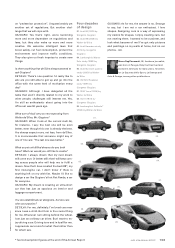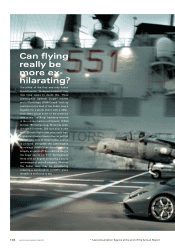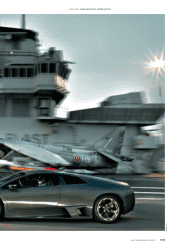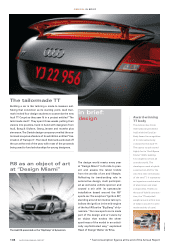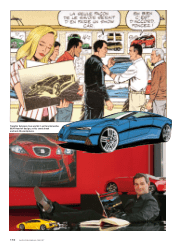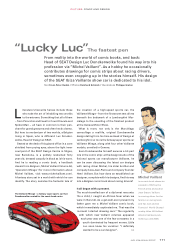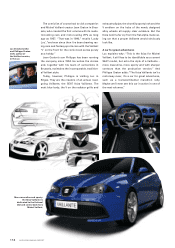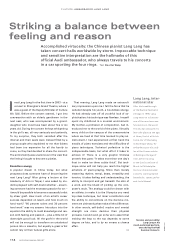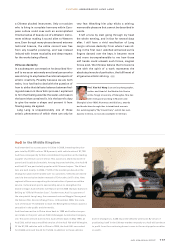Audi 2006 Annual Report Download - page 109
Download and view the complete annual report
Please find page 109 of the 2006 Audi annual report below. You can navigate through the pages in the report by either clicking on the pages listed below, or by using the keyword search tool below to find specific information within the annual report.
Frank O. Gehry’s
buildings
쐽California Aerospace
Museum, Santa Monica,
California (1982–1984)
쐽American Center, Paris
(1991–1994) (currently the
Cinémathèque Française)
쐽Zentrum für Kommu-
nikation und Technologie,
Bad Oeynhausen
(1991–1995)
쐽Guggenheim Museum,
Bilbao (1991–1997)
쐽Dancing House
(Tanˇcicí düm), Prague
(1994–1996)
쐽Neuer Zollhof,
Düsseldorf/Medienhafen
(1997–1999)
쐽Energie-Forum-
Innovation, Bad Oeyn-
hausen (1992–1995)
쐽Experience Music
Project, Seattle
(1999–2000)
쐽Gehry Tower, Hanover
(2000–2001)
쐽DZ BANK building,
Berlin (2001)
쐽
Walt Disney Concert Hall,
Los Angeles (1989–2004)
쐽
Museum MARTa Herford,
Herford (2001–2005)
Breathtaking
appearance: the star
architect loves to
design distorted build-
ing shapes that confuse
the onlooker’s eye.
Left: the Guggenheim
Museum in Bilbao.
Above: Neuer Zollhof,
Düsseldorf.
PHOTOS (LEFT PAGE): AUDI, (RIGHT PAGE): TIBOR BOGNAN (TOP), GUENTHER ROSENBACH (TOP RIGHT)/CORBIS
107AUDI 2006 ANNUAL REPORT
In this particular instance gleaming alu-
minium – a material that Audi is currently using
to embody innovation in the similarly bold
R8* super sports car – forms the shimmering
skin of a roller-coaster transformed into a con-
cert hall, with astonishingly good acoustics.
The project does not look as if it took Gehry
20 years to push through, initially having to
overcome the bitter opposition of a few cultur-
ally shocked souls who dubbed it a “horror”
and a “violation of the cityscape”. The battle
was worth it. And, he explains, “It is the only
building apart from my villa in Santa Monica
that I use regularly myself. I often go to con-
certs there.”
Gehry regards himself as a friend of, and his
work as part of, the fine arts. “Historically
speaking, architecture was always an art disci-
pline. I don’t know who started it or why, but
latterly architecture seems to have been de-
based in the minds of some people.” Gehry, in
any event, is standing his ground. During his
“moments of truth” at the start of a project, he
feels like a painter in front of a blank canvas.
“Then everything falls into place. Formal and
compositional decisions are taken, the colours
are determined and the materials chosen. You
can’t undo those things once they are done.”
The results corroborate his claim that buildings
are sculptures in the public domain.
This white-haired man has not only given
Los Angeles a new landmark. Having already
won the Pritzker Prize, the architects’ equiva-
lent of the Oscar, in 1989, he cemented his
international acclaim with his design of the
Guggenheim Museum in Bilbao. He is responsi-
ble for a number of other iconic buildings, too.
In Germany, his three buildings for the Neuer
Zollhof in Düsseldorf’s Medienhafen aroused
considerable interest. Berlin, Hanover and
Herford also have the good fortune to boast a
genuine Gehry in their urban silhouette. Nor
is any end to his creative urge in sight: he is
building a 75-storey skyscraper in Manhattan, a
giant basketball arena for the New Jersey Nets
in Brooklyn and another Guggenheim Museum
in Abu Dhabi. His personal wish for a new place
of his own in Venice will probably have to wait.
“I can’t seem to get round to it.” At the start of
his career he designed the famous Norton
House, with its corrugated iron, wire netting,
wood and colourful tiles, here in Venice Beach.
“Cars are cultural expressions of movement;
that of course also inspires me in my work,”
confides Gehry, glancing at the brochure of
the new Audi R8 with a smile. “I wouldn’t mind
taking an R8 for a drive.” We couldn’t agree
more, Mr. Gehry!
* fuel consumption figures at the end of the Annual Report



